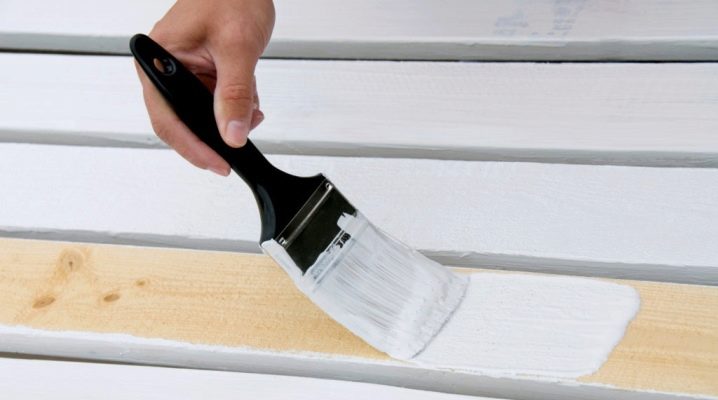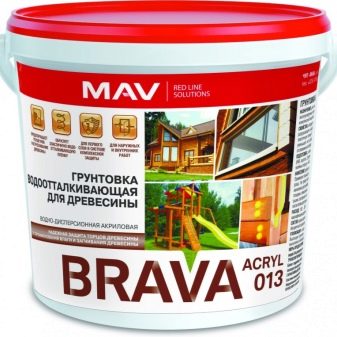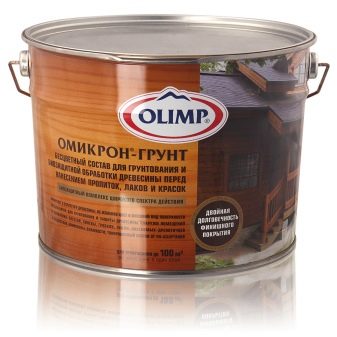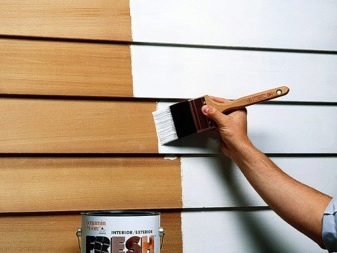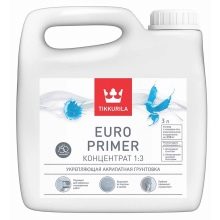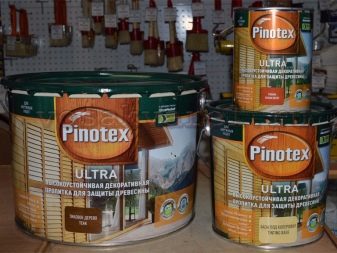What primer to choose for wood surfaces?
Wood is one of the most popular materials in construction and in the manufacture of furniture. Wood has a porous structure and easily absorbs liquids.
To protect the material from external negative influences, to prolong its service life and to facilitate further processing with paints and varnishes, it is necessary to prime the surface. To know which primer to choose for wooden surfaces, it is necessary to study the information on this issue in more detail.
Special features
The priming of wood is a significant and necessary process before finishing the surface. The primer is able to give the wood material many of the necessary qualities for further use,and simplify the process of further surface treatment.
The main purpose of the special composition is as follows:
- Increased adhesion.
- Reduced tree absorption. With further surface treatment with varnish or paint, part of the mixture will penetrate into the wood fibers, which will increase the consumption of paints and varnishes. For the finishing process to be less complicated and costly, wood must first be primed.
- Anti-rot protection. The antiseptic mixture protects lumber from the effects of insects, the formation and spread of fungus and mold, as well as other destructive factors.
- Reinforcement material. Primer solution penetrates deep into the wood structure and prevents the destruction of fibers.
- Moisture protection. Due to the special composition of the primer mixtures after processing wood, a film is formed on its surface. It has water-repellent properties.
- Color change prevention paintwork material when applied. The coloring composition can be applied to the previous layer of paint, but this often leads to a change in color, as the old coating may appear through.Soil can act as a certain separator and will not allow paints to mix.
- Pprevents the release of tannin. Tannin is a natural dye found in wood. This substance can penetrate through the paintwork, forming spots on the surface. The primer fills the pores and prevents its spread.
- Burnout protection when exposed to direct sunlight.
Furniture and other wood structures, which are located in the room, do not need to be primed.
Sometimes it is necessary to preserve the natural structure of wood: in this case it will be sufficient to treat the surface with a colorless impregnation. There are a number of cases in which the process of soil treatment is simply necessary:
- Unheated rooms or rooms with high humidity levels.
- Wooden structures that are outdoors. Such structures especially need protection from external influences (humidity, temperature changes, precipitation). These are fences, doors, stairs, windows, facade elements, and so on.
- In the case of contact of wooden products that are inside the room, with external walls.
- Before processing paints and varnishes.
- Defects on the surface of the wood.
Kinds
The modern market of building materials presents a huge range of soils, which differ among themselves in some features. The general classification of wood based primers is as follows:
- Application area. For outdoor or indoor use.
- Depth of penetration into the tree structure. Allocate usual film structures and deep.
- The basis of the composition: polyurethane, water-based, alkyd, oil, casein.
- Consistency. Liquid impregnation or thick mastic.
- Mix color. The most common option is a clear primer.
- Main functions. Virtually all primers are universal. In this case, it matters what this or that composition is most aimed at: protection from moisture, preventing the appearance of mold and mildew, fireproof function, etc.
All primers can be divided according to two criteria: composition and function. The composition of the following types of primers:
- Acrylic. Distinguished by their penetrating properties.The mixture is almost completely absorbed into the wood structure. Suitable for any kind of paint material. The primer does not have an unpleasant smell and dries quickly (from one to four hours). White acrylic primer is excellent for surface treatment before plastering, applying decorative coatings and painting.
- Alkyd. The composition of the mixture is similar to the composition of alkyd paints. Available in both colorless and pigmented primer of this type. The mixture is applied before painting with alkyd enamels. It can be used as a separating layer before painting an already painted surface. Drying time can be up to eighteen hours.
- Shellac. Well suited for coniferous tree species, as they prevent the release of tar and neutralize their action.
- Epoxy and Polyurethane. Used before surface treatment with paints and varnishes.
- Silicone Acrylic. Possess water-repellent properties. Stabilize the moisture level of wood and protect the surface from moisture.
- Oily. Apply before applying a new layer of paint on an already painted surface.
- Construction. Such a primer after processing wood creates a protective film on the surface. The film prevents the processes of decay and destruction of wood.
- Drying oil. Used for both exterior and interior work as a primer for oil paints. Drying oil protects wood from moisture and prevents rot.
- Polyvinyl acetate. Special primer that is used before applying polyvinyl acetate paint. The mixture includes latex and PVA, which improves adhesion. Drying time is usually thirty minutes.
- Liquid glass. A mixture of liquid glass is used to make the wood hydrophobic properties.
The composition of soil mixtures may include special additives that improve certain functional properties of impregnation. By function, the following priming mixtures are distinguished:
- Antiseptic. It prevents the formation and spread of fungi and mold, as well as kills the existing harmful microorganisms in the wood. Suitable for impregnation of wooden structures that are used in rooms with high humidity or on the street.
- Water repellent. Interfere with penetration of moisture into structure of a tree.
- Firming. These mixtures penetrate deep into the wood fibers and make the material more durable. The strengthening primer is used not only for processing wood, but also for all porous materials. Such a mixture can handle the surface of the foam.
- Varnishing. Varnishing mixtures not only primed the surface, but also form a strong layer of varnish on it. Such material perfectly will be suitable for processing of a wooden floor.
How to choose?
When choosing a primer should be remembered that for different types of finishing works produced special formulations. The application of a primer can have the following purposes:
- Covering under a varnish or paint.
- Processing under putty.
- Putting under the plaster.
- For interior work.
- For outdoor work. For the treatment of wooden structures that are outdoors, it is better to use a water-repellent primer.
The right task will help you find the right primer. Also worth taking into account some useful recommendations:
- for wood surfaces with a low porosity, you should use the most fluid consistencymixtures;
- to preserve the natural appearance of the tree and its structure will allow colorless primer compositions;
- when buying, you should pay attention to such soil characteristics as permissible humidity and air temperature for work;
- pay attention to the drying time of the primer;
- antiseptic, which is part of the soil mixture, will protect the wood not only from mold and fungus, but also from insects.
Famous manufacturers and reviews
Before you make a choice in favor of a soil for wood, it is recommended to get acquainted with the most well-known manufacturers and reviews of their products. Among the most famous and well-established manufacturers of paints and varnishes is the company Tikkurila. The products of this company are of high quality and are in great demand.
Among the primers produced by Tikkurila, Euro Primer and Otex can be mentioned. Euro Primer deep penetration primer is made on an acrylic basis and is suitable for both exterior and interior applications. The composition of the solution includes additives against fungal formations, which allows the use of soil in rooms with a high level of humidity.
Reviews of quality "Euro Primer" extremely positive.Among the advantages are the good absorbency of the mixture, versatility in use and low consumption. The disadvantages include the high cost of soil.
Tikkurila "Otex" is used for surface treatment before painting. Can be used as an intermediate primer - the primer is tinted in 2436 colors. Differs fast drying (one hour under favorable conditions).
Primer "Otex" has only positive feedback. Consumers say that the surface treated with such a composition, the paint falls perfectly. Among the disadvantages emit high cost.
Another world-famous manufacturer of quality materials is the company. Pinotex. This company specializes in the production of products for the protection of wood. Pinotex antiseptics are popular with Pinotex primers. Consumers emit excellent protective properties of the mixture against fungus and mold. The negative qualities include an unpleasant smell.
Company Triora It specializes in water-soluble products and supplies high-quality materials to the construction market at affordable prices.For wood processing, the company is ready to offer a water-based bio-protective agent. Buyers note the following properties of the primer: no unpleasant odor, quick absorption, short drying time, reliable protection.
Application Tips
The process of priming wood is quite simple, but you must first prepare the treated surface. If the surface has roughness and irregularities, you need to resort to grinding. After sanding the wood should be treated with a cloth dipped in solvent - this will remove greasy stains and grime.
Sometimes there is a need to prime a previously painted surface. If it is not necessary to remove the old paint coat, the wood is polished.
In the case of cleaning the surface of the paint, you must use a technical hairdryer.
After the surface has been leveled, cleaned of dirt or an old coating, wood can be primed. It is possible to apply soil by means of the roller, a paint brush or a spray. Some manufacturers produce the soil in cans - in this case, additional tools for the application will not be required. When priming, you should follow some rules:
- Work needs to be carried out at a temperature in the range from 5 to 30 degrees Celsius. At temperatures below five degrees, the drying time of the soil increases. At temperatures above 30 degrees, the mixture evaporates quite quickly, which will impede good wood impregnation.
- It is recommended to apply the primer in several layers. This will allow the mixture to penetrate deeper into the tree structure.
- It is necessary to process chipboard and hardboard with compounds that have the property of deep penetration.
- When treating wood with a water-repellent primer, do not skip areas on the surface.
How to prepare a primer for a wooden surface, see the following video.
